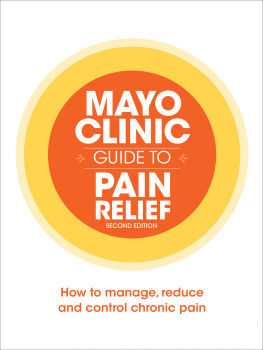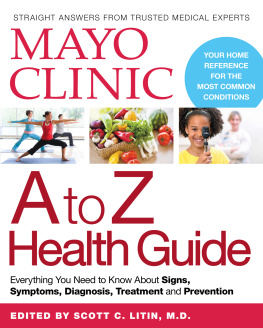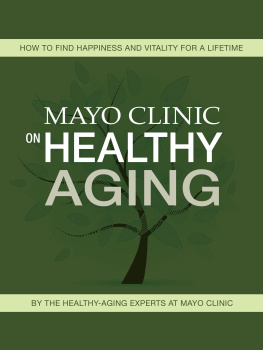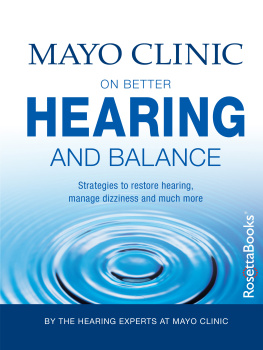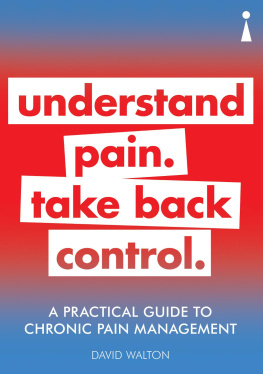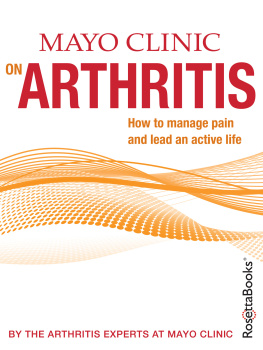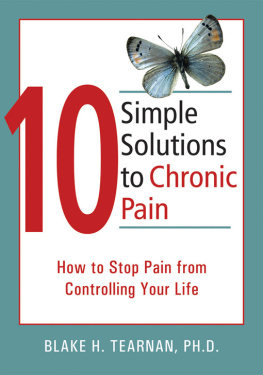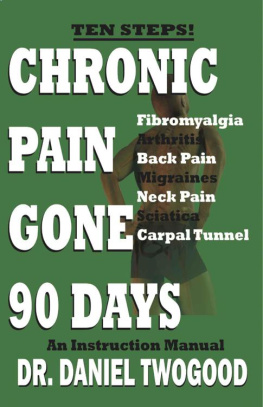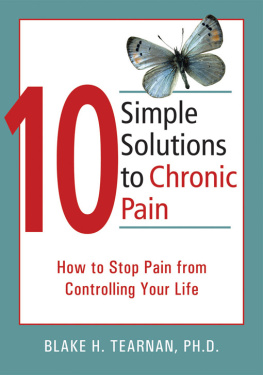

Barbara K. Bruce, Ph.D.
Tracy E. Harrison, M.D.
Medical Editors
Mayo Clinic
Rochester, Minnesota
Mayo Clinic Guide to Pain Relief provides reliable, practical information on managing chronic pain. Much of the information comes directly from the experience of pain specialists and other health care professionals at Mayo Clinic. This book supplements the advice of your physician, whom you should consult for individual medical problems.
This book does not endorse any company or product. MAYO, MAYO CLINIC and the Mayo triple-shield logo are marks of Mayo Foundation for Medical Education and Research.
All rights reserved. No part of this book may be reproduced or used in any form or by any means, electronic or mechanical, including photocopying and recording, or by any information storage and retrieval system, without permission in writing from the publisher, except by a reviewer, who may quote brief passages in review.
For bulk sales to employers, member groups
and health-related companies, contact Mayo Clinic Health Solutions, 200 First St. SW,
Rochester, MN, 55905, or send an e-mail to
SpecialSalesMayoBooks@Mayo.edu.
Published by Mayo Clinic
2014 Mayo Foundation for Medical Education and Research (MFMER)
Second Edition
ISBN EPUB edition: 9780795341823
Editorial staff
Medical Editors
Barbara K. Bruce, Ph.D.
Tracy E. Harrison, M.D.
Managing Editor
Karen R. Wallevand
Editorial Director
Paula Marlow Limbeck
Product Manager
Christopher C. Frye
Art Director
Richard A. Resnick
Illustration and Photography
Joanna R. King
Michael A. King
Kent McDaniel
Production
Downtown Bookworks Inc., New York
Sara N. DiSalvo, product manager
Laura J. Smyth, designer
Proofreading
Miranda M. Attlesey
Donna L. Hanson
Julie M. Maas
Indexing
Steve Rath
Research Librarians
Anthony J. Cook
Amanda K. Golden
Deirdre A. Herman
Erika A. Riggin
Contributors
Kelly M. Amundson, O.T.
Rachel Bartony
Brent A. Bauer, M.D.
Susan M. Bee, R.N., C.N.S.
Aaron J. Biedermann, O.T.
Paul E. Carns, M.D.
Joan B. Cronin, R.N., C.N.S.
Julie L. Cunningham, Pharm. D., R. Ph.
Emily R. Dresher, R.N.
Michele M. Evans, R.N., C.N.S.
Daniel L. Hansen, R.N.
Larissa L. Loukianova, M.D., Ph.D.
Carlos B. Mantilla, M.D., Ph.D.
Virginia R. Nash, R.N., C.N.S.
Matthew A. Petersen, R.N.
John A. Postier, P.T.
Ann M. Reed, M.D.
Susan M. Ryan, C.T.R.S.
Cindy J. Schiebel, O.T.
April L. Shappell, R.N.
Leslie A. Sim, Ph.D., L.P.
Jerry W. Swanson, M.D.
Wendy N. Timm, P.T.
Cynthia O. Townsend, Ph.D., L.P.
Ann Vincent, M.D.
Karen E. Weiss, Ph.D., L.P.
Administrative Assistant
Beverly J. Steele
Preface
To maintain good health and manage illness, its important to have helpful and reliable information. This is particularly true for the common and often-complicated problem of chronic pain.
Advances in the field of pain medicine continue to occur at a rapid pace. This new edition of Mayo Clinic Guide to Pain Relief includes the most recent information on how the nervous system responds to painful illness and injury and common pain conditions such as low back pain, migraines and fibromyalgia.
The pain management strategies presented in this book are based on the expertise of Mayo Clinic physicians, psychologists, nurses, and physical and occupational therapists. We are indebted to the staff of Mayo Clinics Pain Rehabilitation Center, Pain Clinic and Fibromyalgia Treatment Program for their guidance and assistance.
We believe youll find this book to be a helpful and practical resource for effectively managing your pain and finding the relief you seek.
Barbara K. Bruce, Ph.D.

Tracy E. Harrison, M.D.

Medical Editors
Table of contents
Part 1
Understanding chronic pain
Chapter 1
About this book
When youre in pain, theres nothing you want more than relief from the constant throbbing, stinging or aching. With many types of injuries and illnesses, given time, the pain will eventually disappear. But not all pain can be eliminated. For some people, the pain never goes away. Does this mean you can never experience pain relief? No, it doesnt. But it does mean you may have to change your definition of relief.
With some types of chronic, or persistent, pain, medications and interventions are available that can produce a major reduction in pain, and possibly even get rid of the pain altogether. In other instances, however, nothing seems to work. No matter what the treatment pills, a shot, surgery the pain endures. But even in this situation, you can still experience pain relief. Given the right tools and techniques, you can reduce the aching and throbbing to a more tolerable level one that you can live with.
Mayo Clinic Guide to Pain Relief is a comprehensive, how-to pain control manual. Whether youve lived with chronic pain for years or have recently been diagnosed, this book can supply you with the information and tools to minimize and manage your pain. Our hope is that this book will make you a better consumer of medical care for your pain, regardless of the type of pain youre experiencing or how long youve been searching for pain relief.
While the focus of this book is on the treatment of chronic pain, we also provide up-to-date information on treatments used to control short-term (acute) pain that follows surgery or an accident, such as a broken bone.
Why is managing pain important? Pain can interfere with your enjoyment of life. It can make it difficult to sleep, work, socialize with friends and family, and accomplish everyday tasks. When your ability to function is limited, you may become less productive. Ongoing pain can cause you to lose your appetite and feel weak and depressed. You may also find yourself avoiding hobbies and other enjoyable activities in order to prevent further injury or pain. But while your pain may be part of you, it doesnt have to destroy you.
By learning how to manage your pain, you can reclaim your life and become some or all of the person that you used to be. This book is about helping you find the relief you seek.
How to use this book
Mayo Clinic Guide to Pain Relief emphasizes a take-charge approach to successfully managing chronic pain by providing detailed information and instructions on a variety of strategies for controlling pain. These include daily exercise, activity modification, stress-reduction techniques, behavior changes and goal setting. The book also discusses when medications may be useful and why many times medications arent the answer to long-term pain control.
Your level of pain and how much its affecting your ability to function will determine how best to use this book.
If youve just begun to experience persistent pain, you may find the discussion of how pain develops and various treatments for chronic pain most helpful. If youve been battling chronic pain for years and have concluded that medications dont help or they cause unwanted side effects, the last section of the book on pain management strategies can teach you how to better manage your pain without medication.
Next page
